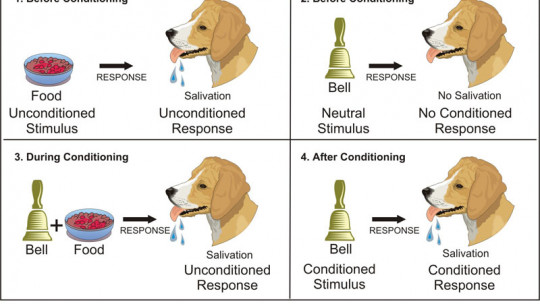Classical conditioning is one of the simplest but most powerful forms of learning known.
Within this procedure, There are different key concepts to understand the potential of this technique, and one of them is latent inhibition Through these lines we will better understand what it consists of and what its importance is.
What is latent inhibition?
Latent inhibition is a concept typical of classical conditioning and refers to the fact that a stimulus familiar to the subject is more complicated to convert into a conditioned stimulus or a signal compared to another that the individual does not yet know and therefore it is neutral for him.
The key to understanding the phenomenon of latent inhibition is to stop for a moment and think about the endless amount of stimuli to which we are subjected from the moment we start the day until we go to bed. Enormous amounts of data reach us through the five senses, but we are so accustomed to most of them that we do not give them the slightest importance. They are just there.
This automatic filtering system of our brain is called latent inhibition. Therefore, if we try to condition the person using any of these stimuli, which already occur normally in their daily life, it will be difficult for them to associate it with the response we are looking for, because Your perceptual system will filter it out of the scheme and you will have a hard time establishing an association
If we did not have this mechanism, we would constantly be suffering from association processes between stimuli that would have little or nothing to do with it, simply because they would occur in our daily lives, in close periods of time, but fortunately latent inhibition acts as protection against this hypothetical situation. possibility of indiscriminate association, which would generate more than one headache in our daily routine.
The original study
The concept of latent inhibition was discovered by psychologists Lubow and Moore , in a study published in 1959, where they explain this phenomenon, observed under laboratory conditions. In their experiment, they divided the subjects into two groups. The first of them was presented with the neutral stimulus, without being followed by any consequences.
After habituation, they began the second phase, in which both the first and second groups were presented, first with the neutral stimulus (to which the first group had already been exposed, but which was novel for the second). and then, the unconditioned stimulus. Once this was done, they compared the results of the conditioning achieved.
Indeed, his prediction came true Greater difficulty was observed in converting the neutral stimulus into a conditioned stimulus in those individuals who had already been previously exposed to it, since they were already accustomed to it and therefore found it more difficult to establish the association between both events.
On the other hand, for the subjects in the second group, the conditioning was very simple, because since they did not know the neutral stimulus in advance, latent inhibition had not been generated in them and therefore they had no problem in quickly establishing the association between the neutral stimulus and the unconditioned stimulus, therefore converting the neutral stimulus into a conditioned stimulus.
Different theories that explain it
Once we know how the phenomenon of latent inhibition works, we could ask ourselves what its explanation is, why it happens like this, not only in human beings but in numerous species of mammals in which it has been shown to exist, which means that this mechanism comes from a common ancestor long before all of us.
To try to provide a plausible explanation for the explanation of this mechanism, different theories have been put forward. One of them maintains that, After a neutral stimulus, which is not followed by any relevant consequence, our brain assigns a reduction in the associativity of said stimulus so it remains in the background from then on, attenuating the attentional processes in relation to that stimulus.
On the other hand, a different theory argues that in reality, in the face of the neutral stimulus an association would be established (to nothing happening), and therefore, when presenting that stimulus to two groups, one that has perceived it before and another who doesn’t, before presenting the unconditioned stimulus, the first group will have a harder time because there is already a previous association that is now competing with the new one while for the other group it would be a single association and therefore would be simpler.
High and low latent inhibition
We have already seen that latent inhibition is a very useful mechanism that we have to discard all the information to which we are exposed at all times and that is not useful for our normal activity. This is what would be considered to have high latent inhibition, that is, one that functions normally and correctly filters out everything that is not useful to us at that moment.
However, Not all people have this skill properly developed , and there are individuals who would have what is known as low latent inhibition. These people, instead of discriminating between those stimuli that are useful to us and those that are not, do not establish any filtering and therefore process each one that is presented to them at every moment, and we have already seen that it is a colossal amount of stimuli.
This situation, obviously, presents a problem for the person who suffers from it, and that is that the level of mental activity required for this titanic task is enormous. Therefore, it is not surprising that, faced with this avalanche of information, without any screening, the brain of an individual with low latent inhibition can collapse.
Not all people with this condition have the strength that such a task requires, so it is important that these individuals work to improve their attention and focusing abilities, since maintaining this exhausting activity for a long time can generate a feeling of frustration. constant to more serious pathologies.
Low latent inhibition and intelligence
The good part of the problem raised in the previous point is that, if individuals with low latent inhibition manage to control that ability to focus to focus each time on the stimuli that matter at that moment, will have a significant advantage over individuals with high latent inhibition since they will be able to pay attention to all the stimuli that are before them and that most of us would ignore without even noticing their existence.
Imagine, for example, the work of a police officer or a detective with this type of capabilities, analyzing all the conditions of a crime scene, paying attention to every small detail, many of which would be almost invisible to the eyes of their colleagues. , with high latent inhibition. This is just one example, but the truth is that these people would have a great advantage in almost all situations.
In fact, although this phenomenon has been studied since the concept of latent inhibition as such was discovered, references to the same idea can be found in much earlier studies, such as those of the Canadian philosopher Marshall McLuhan in the 1960s, and even much earlier, at the beginning of the Gestalt school, at the beginning of the last century.
What is important to be clear about is that, generally, people with low latent inhibition and sufficient mental strength to withstand this condition are people of great intellectual abilities, but This does not imply that all geniuses have that condition , since it does not necessarily always have to be like this. But, if we know a person with a very outstanding and special talent in some field, it is not unreasonable to think that he is an individual with low latent inhibition.
Physiology and neuronal bases
Studies on latent inhibition also make other interesting facts clear. For example, it is demonstrated that dopamine, as well as its agonists and antagonists, have a direct effect on the latent inhibition rate of the individual. In this sense, patients with pathologies such as schizophrenia, present a low latent inhibition at baseline, but when medicated with antipsychotics, such as haloperidol, this rate is significantly increased.
This would explain, at least in part, the effect produced by this type of psychotropic drugs, which seem to extremely relax the patient and considerably reduce their attentional capacity, causing them to stop analyzing all the sensory information that comes to them, being able to focus only on those stimuli. relevant.
On the contrary, If a dopamine agonist substance, such as amphetamines, is administered to a subject, we will obtain just the opposite effect totally reducing latent inhibition and causing the person to capture every last stimulus that is reaching their five senses, paying attention to each one of them, with the mental effort that this implies.









